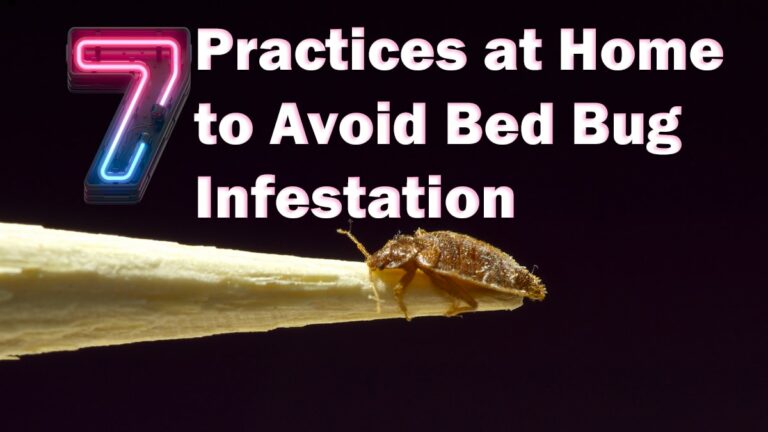Bed bugs are a real problem for many people and their homes. If you’re struggling with an infestation, there are steps you can take to keep yourself safe from these nasty pests. Here are seven practices that will help you avoid bed bug infestation at home:
Don’t store things under your bed
Bed bugs like dark places and can’t jump, but they can crawl very quickly. Bed bugs are not just a problem for houses—they’ve been found in hotel rooms, daycare centers, libraries, and even college dorms! If you find traces of bed bug droppings on your sheets after sleeping on them (like we did), it’s time to get rid of those clothes or things under your bed and head over to our next step: washing everything thoroughly with hot water (or dry-cleaning if that’s available). If there are still some eggs left behind after washing, cover them up with sticky tape or duct tape until they hatch into adults; then move on to step 3 below.
Vacuum regularly
It is highly recommended to vacuum your entire house, including the mattress and box spring, once a week. You can also use a vacuum with a HEPA filter that will help remove all traces of bugs from your home as well as other allergens such as dust mites and pollen particles that might be present in the air around you.
- Wipe down all surfaces with rubbing alcohol before storing them away for long periods of time (i.e., furniture). After cleaning them thoroughly with soap or disinfectant solution, wipe off any excess liquid so that there are no spots left behind which may harbor bed bugs or other harmful insects when it comes time for them to emerge from hiding places at nightfall.
Wash sheets and blankets often
The best way to prevent bed bugs from infesting your home is by washing your sheets and blankets frequently, especially if you have kids. Bed bugs can be found anywhere—even in the seams of a mattress or box spring! Wash them separately from other items in the laundry machine so that they don’t get mixed up with other things that may cause an allergic reaction (like wool). If you choose not to wash your bedding at all, make sure it’s dry before putting it away for storage.
Use a protective cover on your mattress
If you haven’t already done so, it’s time to start using a protective cover for your mattress. This will help prevent bed bugs from coming into contact with what they consider their food source: humans sleeping on top of them. If you don’t have one yet, there are several options available; most notably, covers come in different materials and sizes so that they can fit around any type of bed frame or box spring that might be used in the home (i.e., traditional metal frames vs futons). You should also consider purchasing an interceptor if possible—these devices help trap insects before they can get into the mattress itself and infect other parts of your house.
Put anything that can’t be washed in the dryer on high heat
The easiest technique to get rid of bed bugs is to dry up their hiding spots if you have an infestation. Make sure all things are well cleaned before placing them in the dryer since the heat from the dryer can destroy any bed bugs that are on your clothing or furniture.
The ability to tolerate temperatures beyond 120 degrees Fahrenheit (50 Celsius) for a brief period of time before dying off completely—but not above 140 degrees Fahrenheit—indicates that bed bugs are heat resistant but not heat tolerant (60 Celsius). It’s likely that this procedure will be adequate if used properly when you put everything that can’t be washed in the dryer on high heat for several hours at least once each week until all traces of infestation have been eradicated from it.
Avoid second-hand furniture
Secondhand furniture is one of the most typical sites where bed bugs are discovered. You run the risk of being infected if you buy secondhand furniture from an area where they are prevalent since they may go up to 12 months without eating.
Clothing, luggage, and other personal things from contaminated places have all been reported to carry bed bugs. Be cautious to inspect your companions’ possessions before bringing them back into your house if they have lately experienced bed bug bites.
Inspect your purchases for bed bugs before bringing them home
When you purchase new items, it’s important to inspect them for signs of bed bugs before bringing them home. Bed bugs are small, so you may not see them if they’re hiding in a crack or crevice. Look for black dots that are about the size of a grain of rice—these marks are often left behind by bedbugs who have been crushed between two things after being spotted by their host (you). If you want to be extra careful and make sure no bed bugs have been transported with your new purchases, use a flashlight during this inspection process.
You can protect yourself from bed bug infestation
There’s no need to freak out if you’re concerned about a bed insect infestation! In fact, if you follow these instructions when cleaning up after yourself at home in advance of summer vacation (or just because), there’s a good chance that this year’s bed bug experience won’t be like last year’s—you won’t have them creeping up into every nook and cranny of your home like they did.
Made for Deep Sleep
You can take steps to avoid bed bug infestation at home. Bed bugs are a growing problem in the United States and they have spread as far as South Africa, where they’re found in hotels, guest houses, and even homes. Bed bugs are small insects that feed on humans when we sleep or rest on our beds. They can also bite through clothing and cause rashes that itch intensely — especially if you have an allergy to them (which most people do). In addition to causing physical discomfort, bed bug bites may lead to infection—and it’s not just the skin that gets infected; some people develop serious illnesses like hepatitis B or C from being bitten by these parasites.
It’s hard to stay vigilant when it comes to bed bugs, but there are many things you can do at home to avoid infestation. Remember: prevention is the best cure for this problem!

